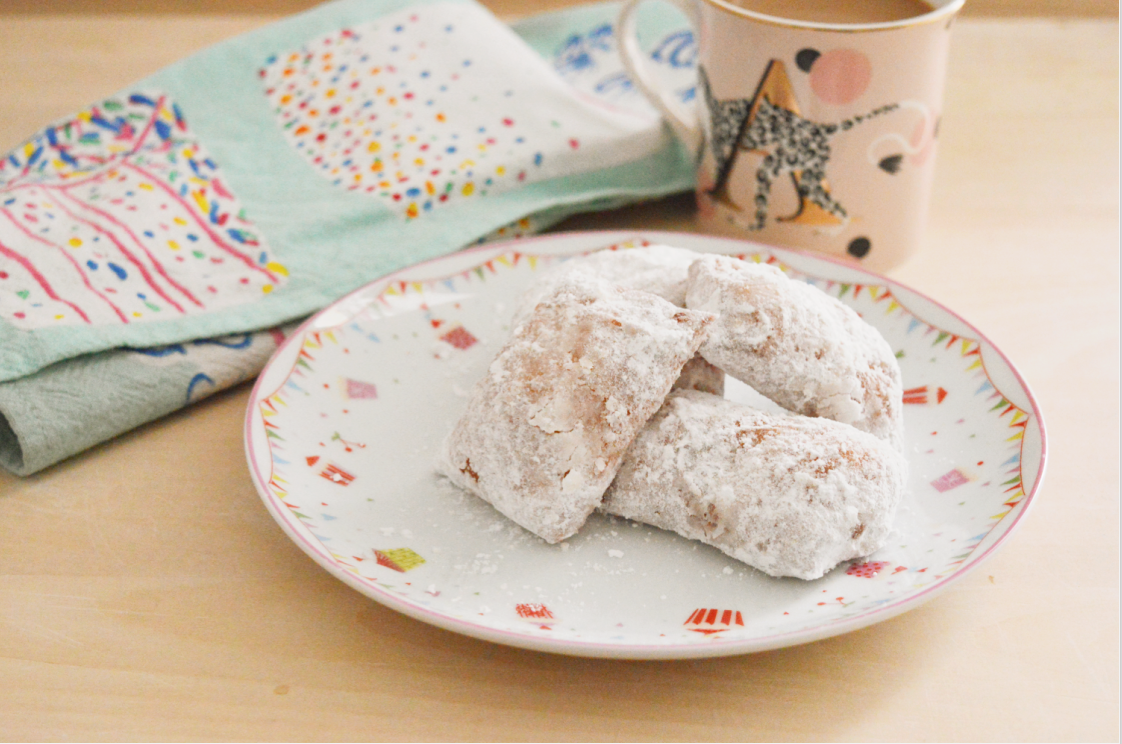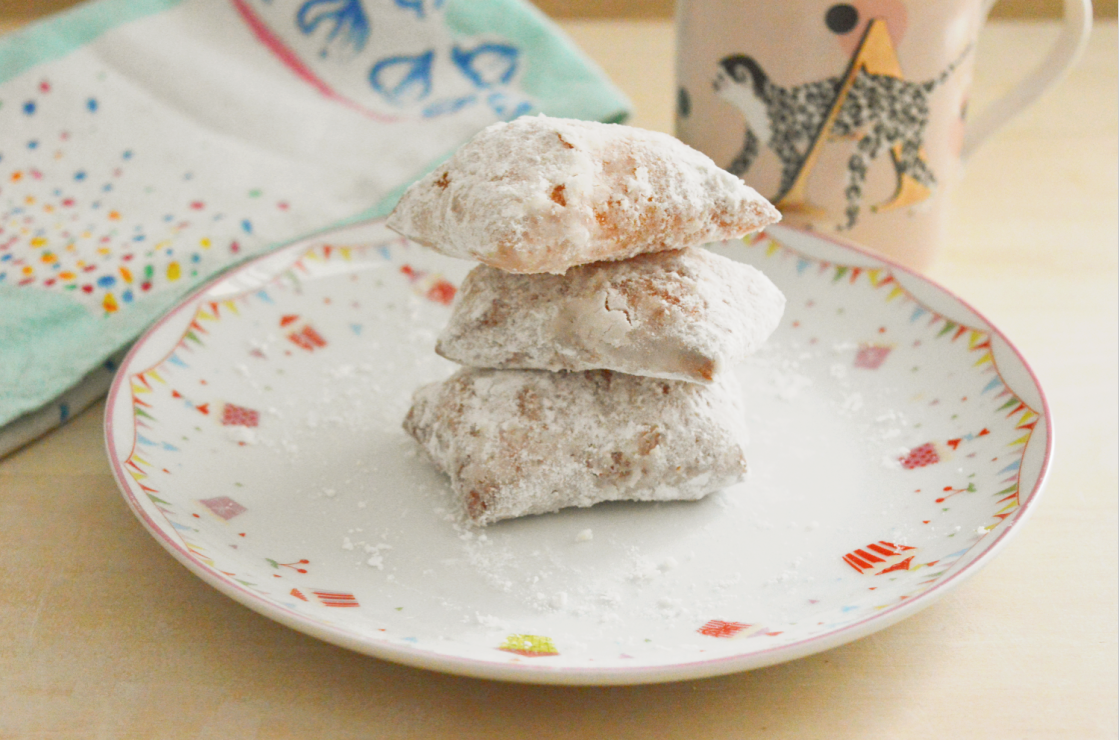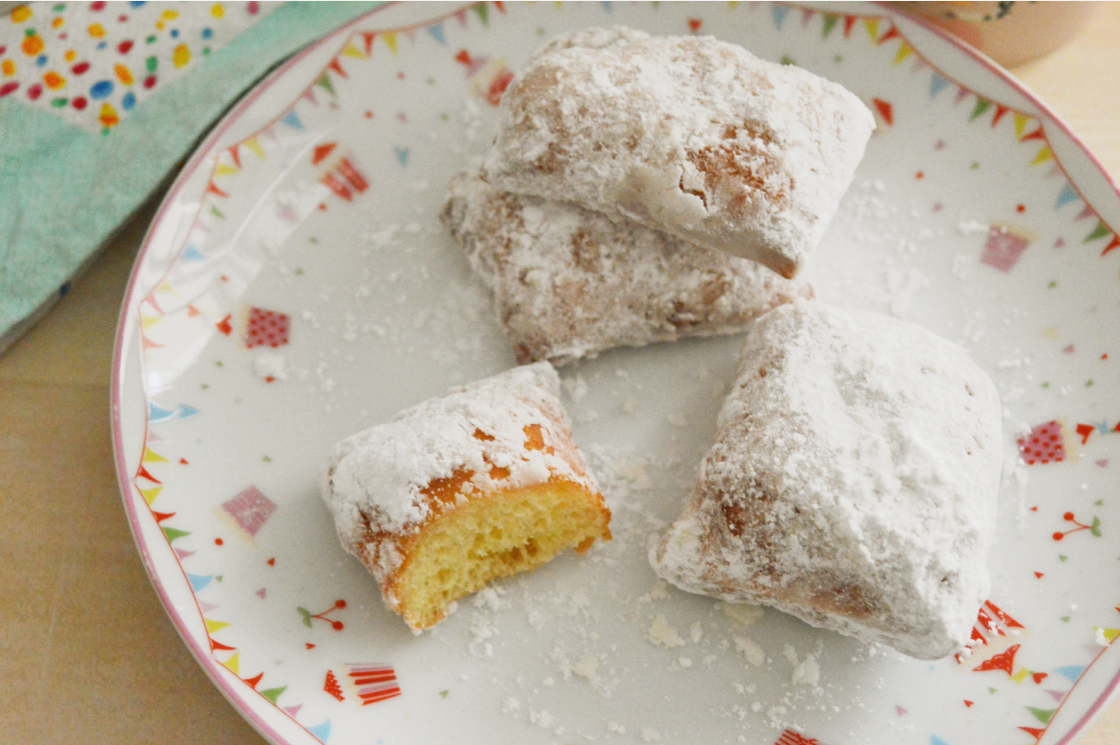New Orleans-Style Beignets
As someone raised in a family of excellent cooks and who has lived in Italy for over a decade — I (humbly) define myself as no stranger to great food. I am lucky enough to have been raised on my grandfather’s lasagne alla bolognese and my mom’s carrot cake, not to mention the bucatini all’amatriciana, carciofi alla giudia, and coda alla vaccinara that have become commonplace to me here in Rome.
Having said this, there are certain foods/dishes I have come across in my 34 years that are so stellar as to remain forever imprinted on my foodie brain, thus joining the ranks of The Best Things I Have Ever Eaten. I’m not talking about nostalgic, home-cooked dishes — ones you have come to rely on and expect — but rather those unforgettable, knock-your-socks-off kind of gastronomic experiences that you stumble upon unexpectedly, sometimes in far away places. You know what I mean, right? That indelible memory of your first ever Chocolate Chip Cookie? A bite of a sun-ripened peach from your own garden? A taste of a creamy-crisp cannolo while traveling in Sicily?
In the hope that I have explained this phenomenon well — but in the event I have not! — here are a few of mine:
1. French Toast Sticks - Disney World Character Brunch - age 5
2. Nobu’s fried spicy rock shrimp tempura - Miami - age 15
3. My Zia Marcella’s pasta with ragù - Torino - age 16
4. The sweetest, most candy-like cherry tomatoes I’ve ever eaten - a beach in Sardegna - age 22
5. A massive chocolate chip cookie from Le Levain Bakery - NYC - age 29
6. Strawberry Jam, made by Carla Tomasi - Rome - age 31
…there are lots more I could tell you about, but let me focus on the another item on the List, and the subject of today’s post: Beignets (ben-yays!).
I first visited New Orleans, Louisiana in 2013, admittedly with the skeptical air of one who has lived a while in Italy (surely my now extra refined tastebuds wouldn’t be so easily impressed by the cuisine here!) I was swiftly proven wrong. We dined spectacularly in NOLA, sampling everything from peppery gumbo to Po’ Boys with crisp fried shrimp to buttery rich Bananas Foster, among others. And then — pause for dramatic effect — there were the legendary beignets at the city’s historic Café du Monde. Served alongside cups of chicory coffee, the beignets were brought to the table still warm, dusted generously with powdered sugar. Unassuming as they may have seemed — squares of fried dough — I realized upon first bite that they were not to be underestimated. The beignets in NOLA tasted tasted like fried, sugar-dusted joy. They were dreamy, divine, transcendent, and they instantly made the List.
After years of reminiscing about the beignets I ate in New Orleans a decade ago, I decided to attempt my own, and just in time for Mardi Gras (beignets are a mainstay at Fat Tuesday festivities). I stocked up on powdered sugar, dug out my frying thermometer, and invited a group of friends over for brunch. Fingers and toes crossed, I mixed, kneaded, rolled, cut, and fried, eventually ending up with — swoon! — a small mountain of beignets that matched those etched in my memory. They were soft and pillow-y and warm and sugary, addictive in that fried-dough sort of way, and I was transported back to NOLA upon first bite. Best of all, the dough was easy to work with (the butter prevented any sticking), they could be made in advance, and only one rise was needed. They were just as delicious served with a caffe’ latte as they were with chicory coffee, for the record. I foresee many, many more batches in the future.
Fun fact: a German friend of mine who was one of my taste testers informed me that in Germany, there is a very similar fried treat called Fasnetsküchle. Who knew the American beignet had a German cousin?
A couple of notes: If you’d like, you can start the dough the night before, and let it rise slowly overnight (see step #5 - let it rise completely in the fridge, and let it come to room temperature before rolling). This recipe was excellent, but I found that the quantities were a bit off — it makes far more than the 16 beignets it accounts for, more like 25-30. The 3 cups powdered sugar called for left me with a lot of leftover powdered sugar — I think that 2 cups should do the trick. I know that things that are fried should be eaten ASAP, but the leftover beignets were pretty good when warmed up in the microwave for 10-15 seconds (just dust with a tiny bit more powdered sugar to spruce them up). Finally, the beignets made from dough that rested two hours and then was rolled, cut, and fried had more of a hollow center — light and airy and perfect for filling with Nutella etc, if you’d be so inclined. The beignet dough that I cut and fried a few hours after after brunch were more like a doughnut on the inside, with no hollow center. I’m sure this has something to do with the scientific side of baking, but rest assured that they are delicious both ways.
Looking for other brunch/breakfast recipes? Click here.
Looking for more recipes for fried sweets? Click here.
NEW ORLEANS-STYLE BEIGNETS
Makes 25 beignets (see my notes above). Recipe from Simply Recipes.
Ingredients:
3 cups (415 grams) all-purpose flour, plus more for dusting
3/4 teaspoon (4.5 grams) kosher salt
3 tablespoons (65 grams) sugar, divided
1 cup (240mL) warm whole milk, about 100°F
2 teaspoons (about 6 grams) active dry yeast
1 large egg
3 tablespoons (42 grams) butter, melted
1 1/2 to 2 quarts vegetable oil
2 cups (200 grams) powdered sugar (see my notes above)
Directions:
1.) In a large bowl, or in the the bowl of a stand mixer fitted with the paddle attachment, combine 3 cups of flour, salt, and 2 tablespoons of sugar.
2.) In a medium bowl, combine the warm milk (it should be about 100°F), remaining tablespoon of sugar, and yeast, and allow it to sit until foamy, about 5 minutes.
3.) Whisk the egg into the foamy milk mixture and add the mixture to the mixing bowl of flour. Mix by hand or using the paddle attachment with your stand mixer set to low or medium low, until you get a wet dough with shaggy dry bits throughout. This can take anywhere from 30 seconds to 1 1/2 minutes depending on how you’re mixing.
4.) If you’re using a standing mixer, swap out the paddle attachment for the dough hook. Otherwise, use a wooden spoon. Add the melted butter. and mix/stir until the butter is incorporated, about 1 minute.
5.) If you have a standing mixer, turn the mixer up to medium and knead on the hook for about 6 minutes. Otherwise, turn the dough out on to a clean surface and knead by hand. The dough should be tacky to the touch but not so wet that you can’t handle it. Shape the dough into a ball and place it in a greased bowl. Cover with plastic and allow it to rise until doubled in size (about 2 hours).
6.) Fill a large pot with a few inches of vegetable oil (about 2 quarts). Set a cooling rack over a baking sheet and place it next to the pot of oil along with tongs. Sift 3 cups of powdered sugar into a medium-sized mixing bowl and set next to the rack and a sheet pan.
7.) Once the dough has risen, turn it out onto a floured surface and roll it out into an oblong shape (about 10 inches by 14 inches and 1/4 inch thick). Cut the dough into rectangles and cover with a flour-dusted tea towel to rest while you heat the oil.
8.) Heat the frying oil to 325°F (162 celsius) ideally using a frying thermometer. Fry the beignets in batches until golden, about 1 1/2 to 2 minutes per side.
9.) Use a pair of tongs, a metal slotted spoon, or a frying spider to lift the beignets out of the frying oil and place them on the baking rack. Let some of the fat drain off for about a minute before covering in powdered sugar. You want to coat them with sugar while the beignets are still hot, but not straight out of the fryer dripping in oil. Drop the drained beignets into the bowl with the powdered sugar. Turn to coat. Repeat with the remaining beignets.
10.) Serve warm with another generous dusting of powdered sugar and hot coffee on the side.








